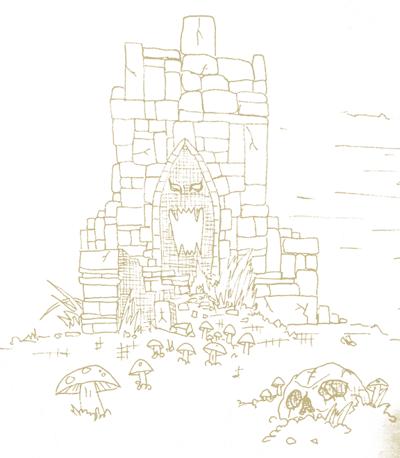One of the coolest features of the conflict system in Torchbearer is that it can be applied to almost any chaotic, dramatic scene— not just fights! However, many of the other conflict types receive a little less attention in the rulebook. For GMs, figuring out how to best use these conflicts can be a bit… tricky.
This week we’re going to take an in-depth look at Trick conflicts, unpacking the meaning of each action, disposition, and compromise.
When to use a Trick conflict
Trick conflicts, like all conflict types, are best used for chaotic scenes that string together several actions. In a trick conflict, one side (the “Trickster”) is trying to lure the other side (the “Mark”) into doing something against their own interest.
If the “trick” is a simple ruse like swapping in a poisoned cup through sleight of hand or leaving false tracks to mislead a pursuer, you’re much better off with a single Manipulator test. These kinds of tricks either work or they don’t.
Great Trick conflicts often involve a sticky situation where one side has a chance to uncover the ruse, and the other side has a chance to cover up any mistakes or evidence. Scenes like:
- A monster hunter trying to pin a troll beneath a portcullis.
- A devil trying to twist the wording of a contract that grants a wish.
- A duchess concealing the presence of her lover in the bedchamber of the jealous duke.
These are perfect candidates for a Trick conflict because there is time and opportunity for the “mark” to discover they are being tricked, and for the “trickster” to cover up their mistakes. Where the short tricks mentioned earlier may only warrant a few seconds in a movie, a conflict is likely to be an entire scene with multiple shots.
Interpreting Trick Conflicts
Once you’ve got an appropriate scene for a Trick conflict, you’re off to a good start. But it’s still easy to lose track of what disposition and actions represent in such an abstract conflict — especially since you’re probably used to thinking of actions in terms of swinging swords and parrying with shields!
To help with this common problem, we at Mordite Press have often found it helpful to add a subtitle to the action types. In this instance, an “attack” played by the Mark is also called “scrutinize” so that we remember what’s going on in the fiction. It’s still an attack action, just with a subtitle. These are given for each action below.
Let’s break down one potential interpretation of the actions, dispositions, and compromises based on whether you’re the “trickster” or the “mark” in the conflict.

The Trickster
The trickster aims to mislead the mark into performing a certain act. This act should be specified when disposition is rolled. Everything revolves around this, so it’s worth being explicit.
Disposition (Manipulator + base Will)
At zero disposition, the Trickster is discovered, and the Mark may choose to avoid the trap. If there’s a tie, the Trickster is discovered, but the Mark still fell for the trap. If the trickster wins, the mark fell for the trap and is unaware of the trickster’s intent.
Actions
- Attack (Lure) — The trickster lures the mark into the desired action.
- Defend (Misdirect) — The trickster explains away evidence or misdirects the mark.
- Feint (Force) — Trickster forces the mark into action.
- Maneuver (Con) — The trickster cons the mark with props and distractions.
Compromise
When the trickster loses but earns a compromise, the trick was discovered but…
...the mark took some partial measures toward the foolish act.
...the trick was revealed, but the trickster’s identity was not.
...the trickster was revealed, but the mark takes it as a joke.
The Mark
The mark tries to understand the situation fully to avoid being fooled. Good trick conflicts have a secondary priority where the Trickster would like to get away without being discovered. This can often be the case even if the trick conflict involves a direct conversation with the Mark — they still don’t necessarily realize they are being tricked.
Disposition (Manipulator + base Will)
At zero disposition, the mark falls into the trap. If there’s a tie, the Mark fell into the trap but knows of the Trickster’s intent. If the Mark wins, they avoid the action and are fully aware of the trickster’s intent.
Actions
- Attack (Scrutinize) — The Mark scrutinizes the Trickster directly.
- Defend (Consider) — The mark practically considers the situation.
- Feint (Accuse) — The mark levels an accusation or poses a logical trap that might reveal the Trickster’s intent.
- Maneuver (Investigate) — A maneuver by the mark investigates additional facts about the situation.
Compromise
When the mark loses but earns a compromise, the foolish act is taken but…
...the mark finds evidence that they were fooled.
...the act was not as foolish as the trickster hoped.
...the mark has the sympathy of any bystanders.
Next week we’ll take a look at some general guidelines for exploring any type of conflict in depth using the same methods we used here.
chaos reigns
lord mordeth
Art by Adric Giles and Matt Gibeault (taken from backer rewards for the Grind Zine)



